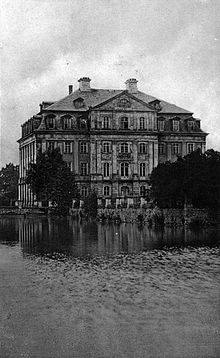Folk high school in Tinz
The Heimvolkshochschule Tinz near Gera as an institution of the People's State of Reuss , later of the State of Thuringia , existed from 1920 to 1933.
It was housed in Tinz Castle (now part of Gera), which formerly belonged to the Reuss dynasty .
Conception
The Heimvolkshochschule Tinz was intended to give young women and men who had previously been denied access to the cultural and educational society the opportunity to acquire comprehensive knowledge in the political, historical, economic and psychological fields, and this was linked to the claim to be independent Stimulate thinking. In addition to these theoretical subjects, great importance was attached to cultural events, and visits to concerts and the theater were an integral part of the curriculum. The Heimvolkshochschule Tinz saw itself as socialist , but without being an institution oriented towards party politics; according to its program it should serve the entire labor movement, not a single branch . 50 men and 50 women were taught alternately in half-yearly courses.
The Heimvolkshochschule Tinz quickly gained a good reputation; If the participants of the first courses were still recruited from Gera and the Gera area, interested parties soon followed from Thuringia, Germany and even from other European countries, above all from Denmark , but also from Belgium and England .
The teachers included a. Personalities such as the economist Alfred Braunthal , the reform pedagogue Anna Siemsen or the later constitutional lawyer Hermann Brill .
Among the students, one should mention Alfred Nau , who later became honorary president of the Socialist International .
history
The spiritual father of the Heimvolkshochschule Tinz was the social democrat Gustav Hennig. Inspired by the Danish concept of an adult education center with boarding school, he advocated the founding of a similar institution in what was then Reuss. On December 11, 1919, the Social Democratic MPs applied for the establishment of a foundation for the purpose of popular education . It was named the Reuss Adult Education Center and was responsible for the institution until 1923. The former moated castle Tinz of the Princely House of Reuss proved to be suitable for accommodation . On March 7, 1920 she started her work with the first half-year course.
After the incorporation of the People's State of Reuss into the newly founded state of Thuringia in 1920 and clarification of the property disputes with the former individual states (state law of April 1, 1923), the foundation was abolished and the school was nationalized. After January 23, 1930, the beginning of the Baum-Frick government , the first German state government in which the NSDAP was represented, the state's grants to the school were canceled; but it could continue until Hitler's “ seizure of power ” in 1933.
The end of the Heimvolkshochschule Tinz came with the beginning of the Nazi regime : On March 17, 1933 a raid squad of the Gera police searched the school; Political material found in the process provided the National Socialists with the reason for the closure. This was ordered on March 19, 1933.
literature
- Ines Lange, In Search of the "New Man" - The Heimvolkshochschule Tinz and the Gera Community School . In: Upstream. Das Moderne Gera between 1900 and 1930. Ed. By: Stadtmuseum Gera and Art Collection Gera, 2005, pp. 121–126
- Manfred Overesch , Hermann Brill. A fighter against Hitler and Ulbricht. Bonn: JHW Dietz, 1992. pp. 179-194
- Bettina Irina Reimers, The New Direction of Adult Education in Thuringia 1919-1933. Essen, Klartext, 2003. pp. 206–217
Web links
Coordinates: 50 ° 54 ′ 14.6 " N , 12 ° 4 ′ 10.2" E
